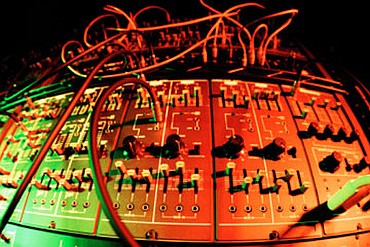Berklee College of Music, says that synthesizers have offered a very significant contribution to the way music is played beyond the sounds they create: Form no longer has to follow function. Acoustic instruments like guitars, cymbals, and clarinets have to be built a certain way to get a very particular sound. “With electronic instruments — namely the synthesizer — all that is out the window,” Rhea says [source: Rhea].
In other words, a synthesizer can make more than one type of sound. It can create tones that are both familiar and otherworldly — a flute, an ocean swell or a Martian’s ray gun — as well as voices that have never been conceived of. Synthesizers achieve these ends by manipulating and combining the fundamental qualities of a sound to create something new. Contrary to popular misconception, the word “synthesizer” is not meant to imply that the sounds produced by the device are synthetic. Rather, it refers to synthesis, the process of combining the various constituent elements — in this case, the fundamental properties of sound — in a way that forms a new whole.
While we’re at it, let’s set aside another misconception: Synthesizers are not voodoo boxes that spit out music without any input. At the end of the day, a synthesizer is just another instrument that requires someone at the controls to make music.
What are the basic components of a sound, and how does a synthesizer change them? Let’s take a look.
Synthesizing the Elements of Sound
When we say that synthesizers manipulate the fundamental elements of a sound, what do we really mean?
First, here are a few basics. A sound is the result of changes in air pressure as energy travels from a sound’s source to our ears. The human ear can process sounds in a frequency range from 20 to 20,000 hertz, and we perceive every sound to have a different pitch, timbre (or tonal quality) and loudness. Even if two instruments play the same musical note, the measurable characteristics of each sound — like frequency (number of repetitions of the wave in one second), amplitude (volume, or the change in air pressure), wavelength (the distance between cycles of a waveform) and period (the time it takes for a waveform to repeat a full cycle) — can vary dramatically. Sounds also contain harmonics, or layers of frequencies that combine to make a full, complex voice. Finally, there are the changes in volume that take place over the lifespan of a sound. This process, which encompasses the peak volume once the note is struck all the way through its inevitable dissolution, is described as attack, decay, sustain and release (ADSR).
We mentioned that the word synthesizer derives from “synthesis.” There are many types of synthesis, but let’s talk about the process of subtractive synthesis, one of the most commonly used forms when creating sounds with a synthesizer. In short, a musician begins with a waveform — a sound which contains all of the characteristics mentioned above — and subtracts components until the desired tone is achieved. The musician can adjust the settings of the synthesizer to strip away and silence certain frequencies, or emphasize and heighten others. In the end, subtractive synthesis can change that initial waveform to become a much different sound. Once it exits the synthesizer, the sound can have similar qualities to a trumpet, a snare drum, an atmospheric whoosh or virtually anything else. (However, unless you use a sampler — an electronic instrument that records and processes pieces of acoustically generated sound — no synthesized version of a real-world instrument will ever be an exact copy.)
Now that we know about how a synthesizer manipulates sounds, let’s go under the hood and take a look at the components of a synthesizer.
For more Detail: How Synthesizers Work

